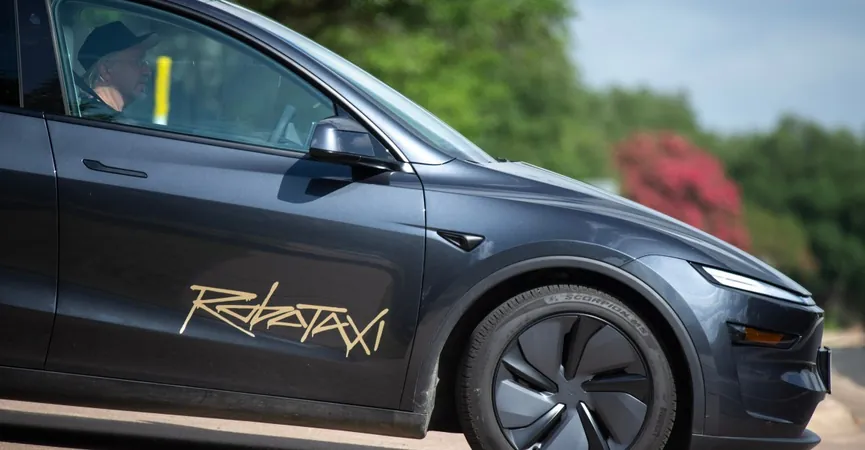
Tesla's Robotaxi Launch: First Reactions and What You Need to Know!
2025-06-22
Author: Ken Lee
Tesla has officially launched its long-awaited robotaxi service in Austin, Texas! As of June 22nd, excitement buzzes with the first reactions pouring in, but the road ahead isn't without bumps.
The Fine Print: What You Should Know
Before diving into the user experiences, it's crucial to highlight some key details. Unlike Elon Musk's initial bold claims, this service isn't fully autonomous or open to everyone just yet. Instead, each robotaxi features a Tesla-employed "safety monitor" who can take control in emergency scenarios—a unique approach compared to other companies who usually use monitors only during testing.
Geofenced and Exclusive!
The rides are currently limited to a carefully mapped area of Austin, with backup support in the form of chase cars and remote drivers, though some rides have proceeded without them. Also, for now, the service is invite-only, with early access granted to several pro-Tesla influencers. This raises questions about how impartial these initial reactions will be!
Limited Testing and Slow Starts
Set within a small, safe zone of Austin, the trial utilizes 10-20 Model Y vehicles, distinctly branded as "Robotaxi." A fully autonomous Cybercab won't roll out until 2026. Operating hours are between 6 AM and midnight, explicitly avoiding complex routes and poor weather conditions—an obvious move to ensure safety.
Early Bird Testers Wait in Anticipation
On launch day, some invitees reported they hadn’t yet received access to the robotaxi app by early afternoon. Pro-Tesla enthusiast Sawyer Merritt even noted the presence of 30 Waymo vehicles while he awaited his ride. Musk later announced that rides would begin that afternoon, with a cheeky $4.20 flat fee—an allusion to his infamous past with cannabis culture.
Caught on Camera: First Experiences
Once testers gained app access, they began sharing their experiences, documenting every step of their robotaxi rides. Many noted that the app interface felt similar to Uber's, and the first journeys were mostly uneventful, described as "smooth" and "normal." Notably, testers experienced some difficulty in locating their designated pick-up spots.
The Robotaxi vs. Human Touch
Inside the vehicle, safety monitors verified riders’ identities by checking their apps, remaining largely silent throughout the journey. This approach raises questions about future systems, especially if Tesla eventually removes the monitors. Unlike Waymo's operations, which require customers to unlock vehicles via their app, Tesla relies on the onboard monitors.
Remote Support and Reality Checks
Once the ride started via an animated 'start' button, riders were greeted by familiar music from their saved playlists. Observations showed that while the vehicles handled standard driving scenarios well, speeds remained capped at around 40 mph. One tester hinted at a moment that required remote operator intervention, although they refrained from labeling it a "disengagement."
What's Next for Tesla?
With the initial launch underway, the bigger picture looms large. Musk has plans for a robotaxi rollout in California, where regulatory challenges are significantly greater. Optimistically, he envisions over a thousand driverless robotaxis on the road within months.
Comparing the Competition
Meanwhile, competitors like Waymo are already operating 1,500 driverless vehicles across multiple cities, with ambitions to expand. As Tesla takes its first steps into this ambitious frontier, the race for dominance in the autonomous vehicle market has only just begun.
Stay tuned as we bring you more updates on this revolutionary service!


 Brasil (PT)
Brasil (PT)
 Canada (EN)
Canada (EN)
 Chile (ES)
Chile (ES)
 Česko (CS)
Česko (CS)
 대한민국 (KO)
대한민국 (KO)
 España (ES)
España (ES)
 France (FR)
France (FR)
 Hong Kong (EN)
Hong Kong (EN)
 Italia (IT)
Italia (IT)
 日本 (JA)
日本 (JA)
 Magyarország (HU)
Magyarország (HU)
 Norge (NO)
Norge (NO)
 Polska (PL)
Polska (PL)
 Schweiz (DE)
Schweiz (DE)
 Singapore (EN)
Singapore (EN)
 Sverige (SV)
Sverige (SV)
 Suomi (FI)
Suomi (FI)
 Türkiye (TR)
Türkiye (TR)
 الإمارات العربية المتحدة (AR)
الإمارات العربية المتحدة (AR)